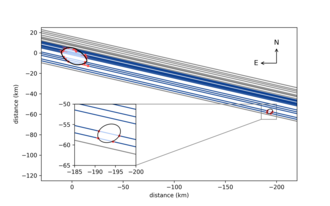15094 Polymele
V–I = 0.799±0.068[10] | |
| 11.60[1][3][7][11][12] 11.691±0.002 (S/R)[8] | |
15094 Polymele
Orbit and classification
Polymele is a
Naming
This
Physical characteristics
Polymele has been characterized as a primitive
Size, shape, and albedo
According to the survey carried out by the
On 27 March 2022, multiple astronomers observed a
Rotation
In March 2016, a rotational
The resolved observation of Polymele's shape in multiple occultation events allowed the Lucy team to determine the orientation of Polymele's rotational pole.
Satellite

Following observations of an occultation on 26 March 2022, the Lucy mission team reported the discovery of a natural satellite around Polymele. The satellite is a smaller asteroid about 5–6 kilometers (3.1–3.7 miles) in diameter, orbiting nearly in the equatorial plane of Polymele at a distance of 204.4 ± 2.6 km (127.0 ± 1.6 mi).[14][5] Assuming Polymele has a density of 0.7–1 g/cm3, the satellite should have an orbital period between 14.4 and 16.6 days.[5] It will not be assigned a formal name until further observations determine its orbit.[18] The Lucy team refers to the companion by the temporary informal name "Shaun," after Aardman Animations' animated sheep.[16] The satellite was detected again in an occultation on 4 February 2023,[15] in the largest organized occultation expedition in history. Nearly 200 astronomers across two continents participated in the campaign.[19]
Exploration
Lucy mission target
Polymele is planned to be visited by the Lucy spacecraft which launched in 2021. The flyby is scheduled for 15 September 2027, and will approach the asteroid to a distance of 415 km (258 mi) at a relative velocity of 6 km/s (13,000 mph).[9]
References
- ^ a b c d e f g h "15094 Polymele (1999 WB2)". Minor Planet Center. Retrieved 8 March 2018.
- ^ 'Polymela' in Noah Webster (1884) A Practical Dictionary of the English Language
- ^ a b c d e "JPL Small-Body Database Browser: 15094 Polymele (1999 WB2)" (2015-06-10 last obs.). Jet Propulsion Laboratory. Retrieved 26 September 2018.
- ^ "List of Jupiter Trojans". Minor Planet Center. 20 June 2016. Retrieved 8 March 2018.
- ^ a b c d e f g h i Levison, H. F.; Buie, M. W.; Keeney, B. A.; Mottola, S.; et al. (June 2023). Interpreting the Stellar Occultations of (15094) Polymele – a Lucy Target (PDF). Asteroids, Comets, Meteors Conference 2023. Lunar and Planetary Institute.
- ^ S2CID 119101711. (online catalog)
- ^ Bibcode:2016PDSS..247.....M. Retrieved 26 September 2018.
- ^ . Retrieved 26 September 2018.
- ^ Bibcode:2017LPI....48.2025L. Retrieved 13 April 2017.
- ^ S2CID 54776793.
- ^ )
- ^ a b "LCDB Data for (15094) Polymele". Asteroid Lightcurve Database (LCDB). Retrieved 26 September 2018.
- ^ Bibcode:2016DPS....4820806B.
- ^ Bibcode:2022DPS....5451203B. 512.03. Retrieved 28 January 2023.
- ^ a b c d Buie, M. W.; Keeney, B. A.; Levison, H. F.; et al. (June 2023). Occultation results for the (15094) Polymele system – a Lucy Target (PDF). Asteroids, Comets, Meteors Conference 2023. Lunar and Planetary Institute.
- ^ a b Clark, Stephen (14 June 2022). "Ninth asteroid added to Lucy mission; optimism grows on solar array issue". Spaceflight Now. Retrieved 15 June 2022.
- ^ "MPC/MPO/MPS Archive". Minor Planet Center. Retrieved 8 March 2018.
- ^ "NASA's Lucy Team Discovers Moon Around Asteroid Polymele". NASA. 16 August 2022. Retrieved 17 August 2022.
- ^ NASA/SwRI. "Spotting a Satellite - Lucy Mission". LUCY Mission Page. Retrieved 1 September 2023.
External links
- Asteroid Lightcurve Database (LCDB), query form (info Archived 16 December 2017 at the Wayback Machine)
- Dictionary of Minor Planet Names, Google books
- Discovery Circumstances: Numbered Minor Planets (15001)-(20000) – Minor Planet Center
- 15094 Polymele at AstDyS-2, Asteroids—Dynamic Site
- 15094 Polymele at the JPL Small-Body Database
